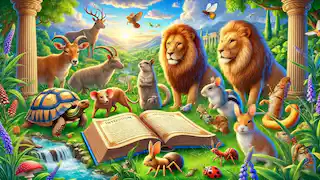The Tortoise and the Hare
Once upon a time in ancient Greece, there lived a tortoise and a hare. The hare was known for his swiftness, while the tortoise was recognized for his slow and steady pace. One day, the hare mocked the tortoise for his slow speed.
“You are so slow, Tortoise! I could run circles around you,” said the hare boastfully.
The tortoise, tired of the hare’s ridicule, responded, “I may be slow, but I can beat you in a race.”
The hare laughed at the tortoise’s challenge but accepted it. They agreed on a race, and all the animals gathered to watch.
As soon as the race began, the hare dashed ahead, leaving the tortoise far behind. Confident of his victory, the hare decided to take a nap under a tree midway through the race. Meanwhile, the tortoise kept moving, slow and steady, never stopping.
While the hare was sleeping, the tortoise passed him quietly. The other animals watched in amazement as the tortoise approached the finish line. The hare, waking up and realizing what was happening, tried to catch up, but it was too late. The tortoise crossed the finish line first, winning the race.

“All the animals cheered for the tortoise, who proved that slow and steady wins the race.”
The hare, embarrassed and humbled, congratulated the tortoise. “I underestimated you, Tortoise. Your perseverance and determination have taught me a valuable lesson.”
The tortoise smiled and replied, “It’s not always about speed, Hare. Sometimes, consistency and dedication are what truly matter.”
The Fox and the Grapes
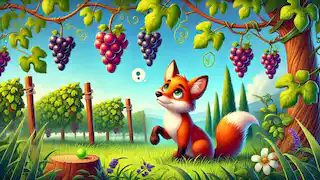
One hot summer’s day, a fox was strolling through an orchard when he spotted a bunch of ripe, juicy grapes hanging from a vine. His mouth watered at the sight.
He jumped up to grab the grapes, but they were too high. He tried again and again, but each time he missed. The fox was determined, using all his cunning and agility to reach the grapes, but his efforts were in vain.
Finally, exhausted and frustrated, the fox gave up. As he walked away, he muttered, “Those grapes are probably sour anyway.”
“This fable teaches us that it’s easy to despise what you cannot have.”
The fox’s journey through the orchard continued, and he encountered other animals who were also striving for their desires. Each one had their own challenges and struggles, but they never gave up. Watching them, the fox began to reflect on his own attitude.
As days passed, the fox realized that his bitterness only held him back. He decided to change his approach. Instead of giving up so easily, he would find new ways to achieve his goals. The fox started practicing his jumps and finding better paths to his desired rewards.
The Lion and the Mouse
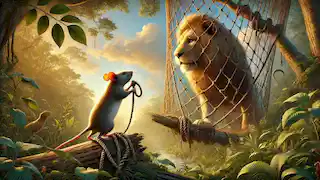
In a dense forest, a lion lay sleeping peacefully. A tiny mouse accidentally ran across his paw, waking him up. The lion caught the mouse with a swift swipe of his paw.
“Please, mighty lion, spare my life!” squeaked the mouse. “One day, I might be able to help you in return.”
The lion laughed at the thought of a tiny mouse helping him but decided to let the mouse go.
A few days later, the lion was caught in a hunter’s net. He roared in anger, trying to break free, but the ropes were too strong. Hearing the lion’s roars, the mouse remembered his promise and ran to help. He gnawed at the ropes until they broke, freeing the lion.
“You laughed at me before,” said the mouse, “but now you see that even a little mouse can help a great lion.”
“This fable illustrates that kindness is never wasted.”
The lion, grateful for the mouse’s help, decided to protect the smaller animals in the forest. He realized that strength was not just about physical power but also about compassion and alliances. The mouse and the lion became friends, and together, they fostered a sense of community among the forest creatures.
The lion shared his wisdom and strength, while the mouse offered his cleverness and agility. They taught the forest animals that everyone had unique talents and that working together made them stronger.
The Ant and the Grasshopper
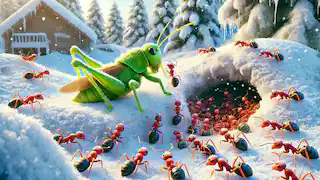
During the warm summer, the ants were busy collecting food and storing it for the winter. A grasshopper, who loved to sing and dance, saw the ants working hard and laughed at them.
“Why are you working so hard?” asked the grasshopper. “Come and sing with me!”
The ants replied, “We are storing food for the winter. You should do the same.”
The grasshopper ignored their advice and continued to enjoy himself. When winter came, the grasshopper found himself cold and hungry. He went to the ants and begged for food.
The ants shared their food but reminded the grasshopper, “You should have prepared for the winter like we did.”
“This fable teaches the value of hard work and preparation.”
The grasshopper, realizing his mistake, vowed to change his ways. As spring arrived, he began to work alongside the ants, learning their ways of preparation and diligence. The ants, seeing his genuine effort, welcomed him and taught him the value of foresight and hard work.
By the time the next winter came, the grasshopper was well-prepared. He had stored enough food and even helped the ants with their preparations. The grasshopper’s transformation inspired other carefree animals to take their future more seriously.
The Boy Who Cried Wolf
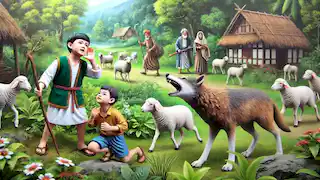
In a small village, a shepherd boy was tasked with watching over the sheep. Bored and seeking attention, he decided to play a trick on the villagers. He ran into the village shouting, “Wolf! Wolf! A wolf is attacking the sheep!”
The villagers rushed to help, only to find no wolf. The boy laughed at their concern.
He played the trick again the next day, and the villagers once more came running, only to be fooled again.
A few days later, a real wolf appeared and attacked the sheep. The boy cried out for help, but this time the villagers did not believe him. The wolf attacked the flock, and the boy learned a hard lesson.
“This fable warns against lying, as it erodes trust and credibility.”
The boy, filled with regret, went to the village elder and confessed his wrongdoing. The elder, seeing the boy’s remorse, decided to give him a second chance. He gathered the villagers and explained the boy’s mistake, urging them to forgive him.
The villagers, although wary, decided to give the boy another chance. They helped him rebuild the flock and taught him the importance of honesty and trust. The boy worked hard to regain their trust, and in time, he became a responsible shepherd.
The Dog and His Reflection

A dog was carrying a bone in his mouth, pleased with his find. As he crossed a stream, he looked down and saw his reflection in the water. Thinking it was another dog with a bigger bone, he snapped at the reflection to grab the other bone.
In doing so, he dropped his own bone into the water and lost it.
“This fable teaches that greed often leads to loss.”
The dog, saddened by his loss, wandered the forest pondering his actions. He came across other animals, each with their own struggles and lessons. A wise old owl, observing the dog’s sorrow, approached him and shared a story of contentment and gratitude.
The dog learned to appreciate what he had and to avoid being blinded by greed. He became known in the forest as a wise and humble animal, often sharing his newfound wisdom with others.
The Crow and the Pitcher
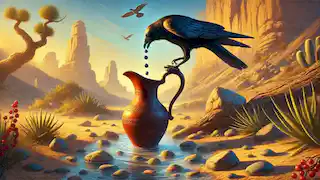
A crow, feeling very thirsty, found a pitcher with a little water at the bottom. He tried to reach the water with his beak, but the neck of the pitcher was too narrow.
Thinking creatively, the crow began dropping pebbles into the pitcher. With each pebble, the water level rose a little higher until the crow could finally drink the water.
“This fable demonstrates that ingenuity and perseverance can overcome obstacles.”
The crow’s cleverness did not go unnoticed. The other birds in the forest started seeking his advice for their problems. The crow, always eager to help, taught them to use their minds and creativity to find solutions.
One day, a drought hit the forest, and many animals were struggling to find water. The crow’s innovative methods saved many lives, and he became a hero in the forest. His story was passed down through generations, inspiring others to think creatively and never give up.
The Wolf in Sheep’s Clothing
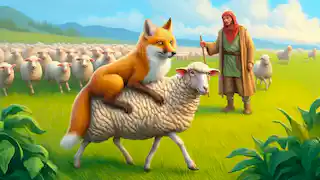
A cunning wolf found a sheep’s skin and wore it to blend in with the flock. Disguised as a sheep, the wolf managed to deceive the shepherd and the flock.
One evening, the shepherd decided to kill a sheep for his dinner. He mistakenly took the wolf, still in disguise. When the shepherd realized his mistake, it was too late.
“This fable highlights that deceit can lead to one’s downfall.”
The shepherd, after realizing his mistake, became more vigilant. He shared the story of the wolf with the other villagers to warn them about the dangers of deceit. The villagers, learning from the shepherd’s experience, became more cautious and attentive to their surroundings.
The wolf's tale also spread among the animals in the forest. They learned that pretending to be something they were not could have dire consequences. The lesson resonated deeply,
teaching them the value of honesty and authenticity.
The Frog and the Ox
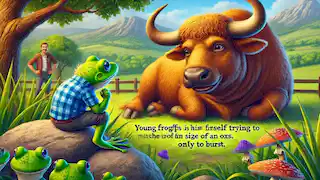
A young frog saw an ox grazing in a field and was amazed at its size. The little frog hurried to his father and described the giant creature. The father frog, proud and arrogant, began to puff himself up to match the ox’s size.
“Was he this big?” asked the father frog as he puffed himself up more and more.
“No, much bigger,” replied the little frog.
The father frog continued to puff himself up until he finally burst.
“This fable warns against trying to be something you are not.”
The little frog, saddened by the loss of his father, learned a valuable lesson about pride and humility. He shared this lesson with the other frogs, warning them not to let their ego lead them into dangerous situations.
The frogs in the pond became more mindful of their limitations and focused on their strengths instead of trying to outdo others. They realized that true strength lay in being true to oneself and not pretending to be something they were not.
The Miser and His Gold

A miser buried his gold in a secret place in his garden. Every day, he went to the spot, dug up the treasure, and counted the gold coins. He never spent a single one.
One day, a thief who had been watching him stole the gold. When the miser discovered the theft, he was heartbroken. A neighbor, hearing of his sorrow, asked, “Did you ever use any of the gold?”
“No,” replied the miser, “I only looked at it every day.”
“Then you might as well bury a stone in the same place,” said the neighbor. “It would do you as much good.”
“This fable teaches that wealth not used is wealth wasted.”
The miser, reflecting on his neighbor’s words, realized the futility of hoarding wealth without purpose. He decided to change his ways, using his remaining resources to help those in need. The villagers, seeing his transformation, forgave his past miserliness and welcomed him into their community.
The miser’s story spread, inspiring others to use their wealth for the greater good rather than letting it go to waste. The village prospered, with everyone contributing to the welfare of the community.
The Fox and the Crow
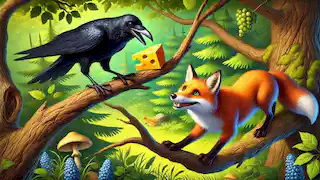
A crow perched on a tree branch with a piece of cheese in its beak. A hungry fox saw the crow and wanted the cheese. The fox devised a cunning plan to trick the crow.
“Oh, crow, how beautiful you are!” said the fox. “Your feathers are so glossy and your eyes so bright. Surely, your voice must be the most beautiful of all the birds. Won’t you sing for me?”
Flattered by the fox’s praise, the crow opened its beak to sing, and the cheese fell to the ground. The fox quickly snapped up the cheese and ate it.
The crow, realizing it had been tricked, felt foolish. The fox, pleased with its cleverness, walked away with a full belly.
“This fable teaches us to be wary of flattery and deceit.”
The crow, wiser from the experience, shared its story with other birds. They learned to recognize false praise and to trust their instincts over flattery. The fox, on the other hand, continued its cunning ways but found it increasingly difficult to deceive others as word of its tricks spread.
The Goose That Laid the Golden Eggs
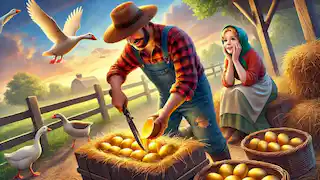
A farmer and his wife had a goose that laid a golden egg every day. They were thrilled and soon became wealthy from selling the golden eggs. However, the farmer grew greedy and impatient.
“If this goose lays golden eggs, there must be a fortune inside it!” thought the farmer. He decided to kill the goose to get all the gold at once.
When he cut the goose open, he found no gold inside, and the goose was dead. The farmer realized his mistake too late and lamented his lost fortune.
“This fable warns against greed and impatience.”
The farmer and his wife, now poor again, shared their story as a cautionary tale. They learned to appreciate the steady income from the golden eggs and regretted their hasty actions. The tale of the goose became a popular lesson in the village, teaching others the value of patience and moderation.
The North Wind and the Sun

The North Wind and the Sun had a dispute about who was stronger. To settle it, they decided to see who could make a traveler remove his cloak.
The North Wind blew with all his might, but the harder he blew, the tighter the traveler wrapped his cloak around him. The North Wind finally gave up.
Then, the Sun gently shone down on the traveler. The warmth made the traveler feel comfortable and relaxed, and soon he took off his cloak.
“This fable shows that gentleness and kindness are more effective than force and bluster.”
The North Wind, humbled by the Sun’s success, realized the power of gentleness. The Sun’s approach became a model for how to handle conflicts and challenges. The traveler, grateful for the warmth, spread the story of the Sun and the North Wind, teaching others the value of kindness and patience.
The Town Mouse and the Country Mouse
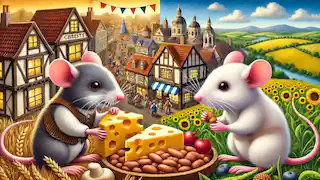
A town mouse and a country mouse were friends. One day, the town mouse visited the country mouse. The country mouse offered simple but hearty food, like beans and corn. The town mouse, used to the finer things, scoffed at the meal.
“Come with me to the town, and I’ll show you how to live,” said the town mouse.
The country mouse agreed and followed his friend to the town. There, the town mouse showed him a grand feast of cheese, pastries, and fruits. However, their meal was constantly interrupted by the dangers of the town: cats, traps, and humans.
The country mouse, terrified, said, “I’d rather have my simple meals in peace than live in constant fear.”
“This fable teaches that a simple, peaceful life is better than a rich life filled with danger and uncertainty.”
The town mouse, reflecting on his friend’s words, visited the country again to find solace from the hectic town life. The two mice remained friends, each appreciating the other’s perspective and finding balance in their lives.
The Bear and the Two Travelers
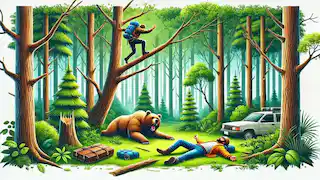
Two travelers were walking through a forest when they encountered a bear. One of the travelers quickly climbed a tree to escape, leaving his friend behind. The second traveler, unable to climb the tree, lay flat on the ground, pretending to be dead.
The bear sniffed the man, thought he was dead, and walked away. The traveler who had climbed the tree came down and asked, “What did the bear whisper in your ear?”
“He told me,” replied the friend, “to never travel with someone who deserts you at the first sign of danger.”
“This fable teaches the importance of true friendship and loyalty.”
The two travelers parted ways, and the story of their encounter spread. People learned to value loyalty and courage in their relationships, understanding that true friends stand by each other in times of need.
The Wolf and the Crane

A wolf had a bone stuck in his throat and could not get it out. Desperate for help, he asked a crane to remove it, promising a reward.
The crane, wary but wanting to help, used its long beak to reach down the wolf’s throat and pull out the bone. When the crane asked for his reward, the wolf sneered, “You’ve already got your reward. I didn’t eat you when you stuck your head in my mouth.”
“This fable warns against expecting gratitude from the ungrateful.”
The crane, realizing the wolf’s treachery, flew away and shared the story with other animals. They learned to be cautious when dealing with those who had shown no signs of trustworthiness. The wolf’s reputation spread, and he found it harder to find help in the future.
The Fox and the Stork

The fox invited the stork to dinner and served soup in shallow bowls, which the stork, with his long beak, could not eat. The stork, hungry and frustrated, realized the fox was playing a trick.
In return, the stork invited the fox to dinner and served fish in a tall jar with a narrow neck. The fox could not reach the food, while the stork easily ate his meal.
The fox, embarrassed and hungry, learned his lesson.
“This fable teaches that trickery and deceit often backfire on the trickster.”
The stork and the fox eventually made amends, realizing that fairness and respect were more valuable than trickery. Their story was told among the animals, teaching the importance of treating others as one wishes to be treated.
The Farmer and the Stork
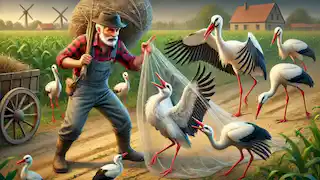
A farmer set a net to catch the cranes that were eating his seeds. He caught several cranes and a stork. The stork pleaded for his life, saying, “Please let me go. I am not a crane. I am a stork, a bird of noble character.”
The farmer replied, “I have caught you with these robbers, and you must suffer the same fate as they.”
“This fable teaches that you are judged by the company you keep.”
The stork’s fate became a warning to others. Birds and animals alike learned to choose their companions wisely, understanding that their actions and character were often judged by the company they kept.
The Miller, His Son, and Their Donkey
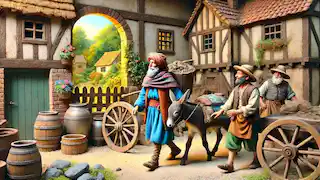
A miller and his son were driving their donkey to market. They passed several people who criticized them no matter what they did. First, they walked alongside the donkey, and people said they were foolish for not riding it. Then the son rode the donkey, and people said he was disrespectful to his father.
When the miller rode the donkey, others said he was cruel to make his son walk.
Finally, they both rode the donkey, and people said they were overloading the poor animal. In an attempt to please everyone, they ended up carrying the donkey, which caused them to lose it in a river.
“This fable teaches that you cannot please everyone and should make decisions based on your own judgment.”
The miller and his son learned to trust their own instincts and not to be swayed by the opinions of others. Their story encouraged people to find a balance between listening to advice and following their own path.
The Eagle and the Arrow
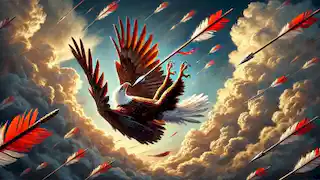
An eagle was soaring through the sky when an arrow struck him. As he fell to the ground, he saw that the arrow was feathered with one of his own plumes.
“This fable teaches that we often give our enemies the means for our own destruction.”
The eagle’s story spread among the animals, serving as a reminder to be cautious of their actions and the potential consequences. They learned to be vigilant and to avoid giving others power over their fate.
Conclusion
Aesop’s fables have stood the test of time, offering timeless wisdom and moral lessons. Through these tales, we learn about the virtues of honesty, kindness, hard work, and humility. They remind us that our actions have consequences and that the values we uphold shape our character and destiny.
